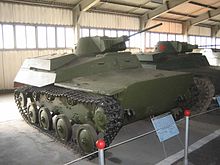T-40
| T-40 amphibious scout tank | |
|---|---|

A T-40 in the Kubinka Tank Museum.
|
|
| Type | Amphibious light tank |
| Place of origin | Soviet Union |
| Service history | |
| In service | 1941–46 |
| Used by | Soviet Union |
| Wars | World War II |
| Production history | |
| Produced | 1940–41 |
| No. built | 222 |
| Variants | BM-8-24 Katyusha, T-30 light tank |
| Specifications () | |
| Weight | 5.9 t (6.5 short tons) |
| Length | 4.10 m (13.5 ft) |
| Width | 2.33 m (7.6 ft) |
| Height | 1.90 m (6.2 ft) |
| Crew | 2 |
|
|
|
| Armour | 4–13 mm (0.16–0.51 in) |
|
Main
armament |
12.7 mm (0.50 in) DShK machine gun |
|
Secondary
armament |
7.62 mm (0.300 in) DT machine gun |
| Engine |
GAZ-202 85 hp (63 kW) |
| Power/weight | 12 hp/tonne |
| Suspension | torsion bar |
|
Operational
range |
450 km (280 mi) |
| Speed | 45 km/h (28 mph) |
The T-40 amphibious scout tank was an amphibious light tank used by the Soviet Union during World War II. It was armed with one 12.7 mm (0.5 in) DShK machine gun. It was one of the few tanks that could ford a river without a bridge.
It was primarily intended to equip reconnaissance units. A land-based version of the T-40, the T-40S, was produced, although was later redesignated the T-60. The T-60 was cheaper, simpler, better-armed, and could fulfill most of the same roles, so T-40 production was halted.
The vehicle served mainly in Operation Barbarossa and the defense of Moscow, and it was rarely seen after that point, although it was used in Soviet training schools until 1946. A total 44 examples of the type were later fitted with Katyusha rocket launchers, firing 82 mm unguided rockets from a 24-rail launcher.
Amphibious capability was important to the Red Army, as evidenced by the production of over 1,500 amphibious tanks in the 1930s. The T-40 was intended to replace the aging T-37 and T-38 tank light amphibians. It was a superior design, but due to the pressures of war the Soviets favored the production of simpler tank designs, so only a small number of T-40s were built.
The T-40 was an improvement over the T-37 and T-38 in several respects. The coil-spring suspension of the T-38 was replaced by a modern torsion-bar suspension with four pairs of road wheels. The boat-shaped hull was entirely welded, in contrast to the riveted hulls of the T-37 and T-38. The welded, conical turret shape improved protection, although the armor was still very thin. The vehicle's armament consisted of a single 12.7 mm DShK heavy machine gun, which was a much more potent weapon than the 7.62 mm DT machine gun mounted on the T-37 and the T-38.
...
Wikipedia
